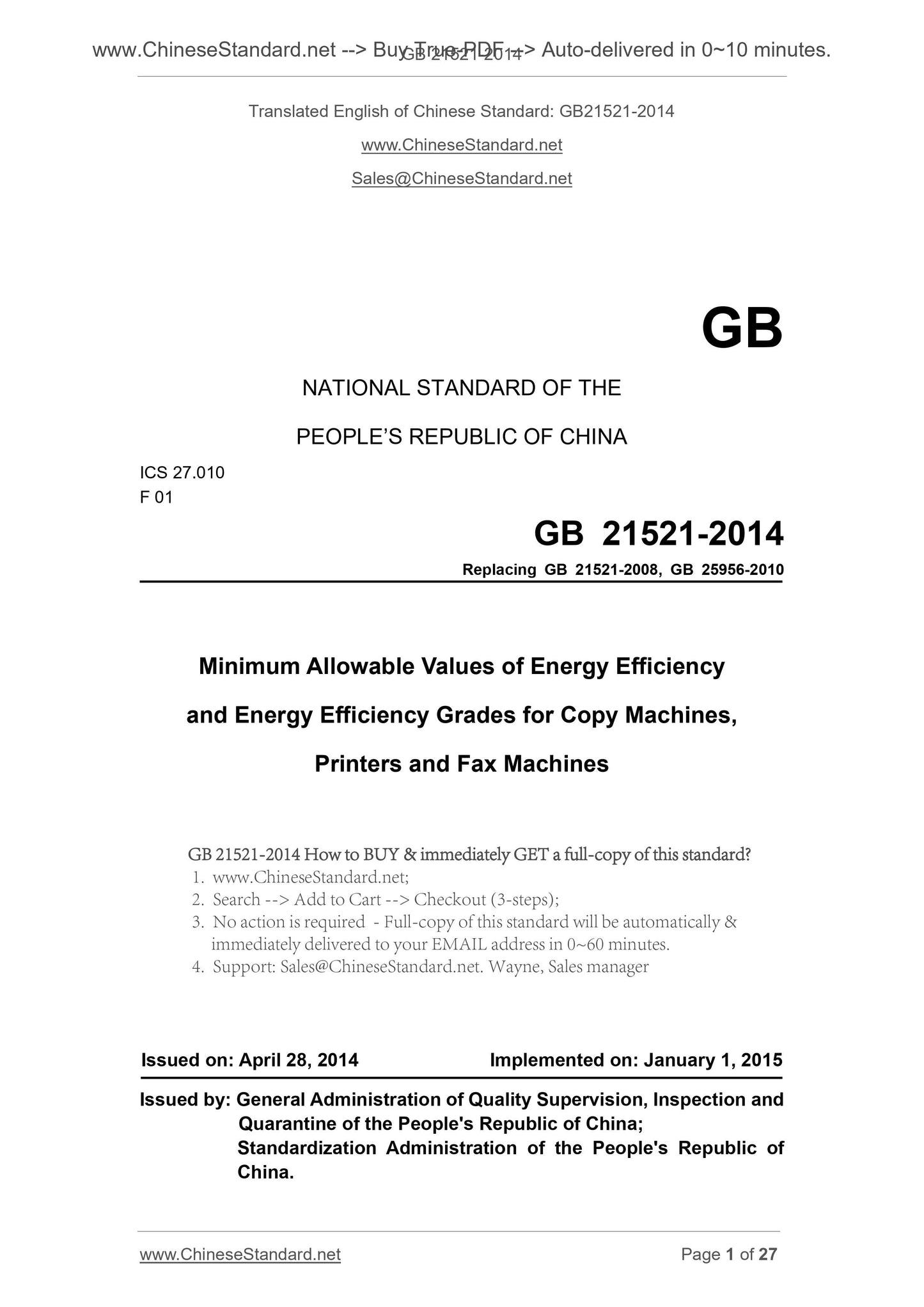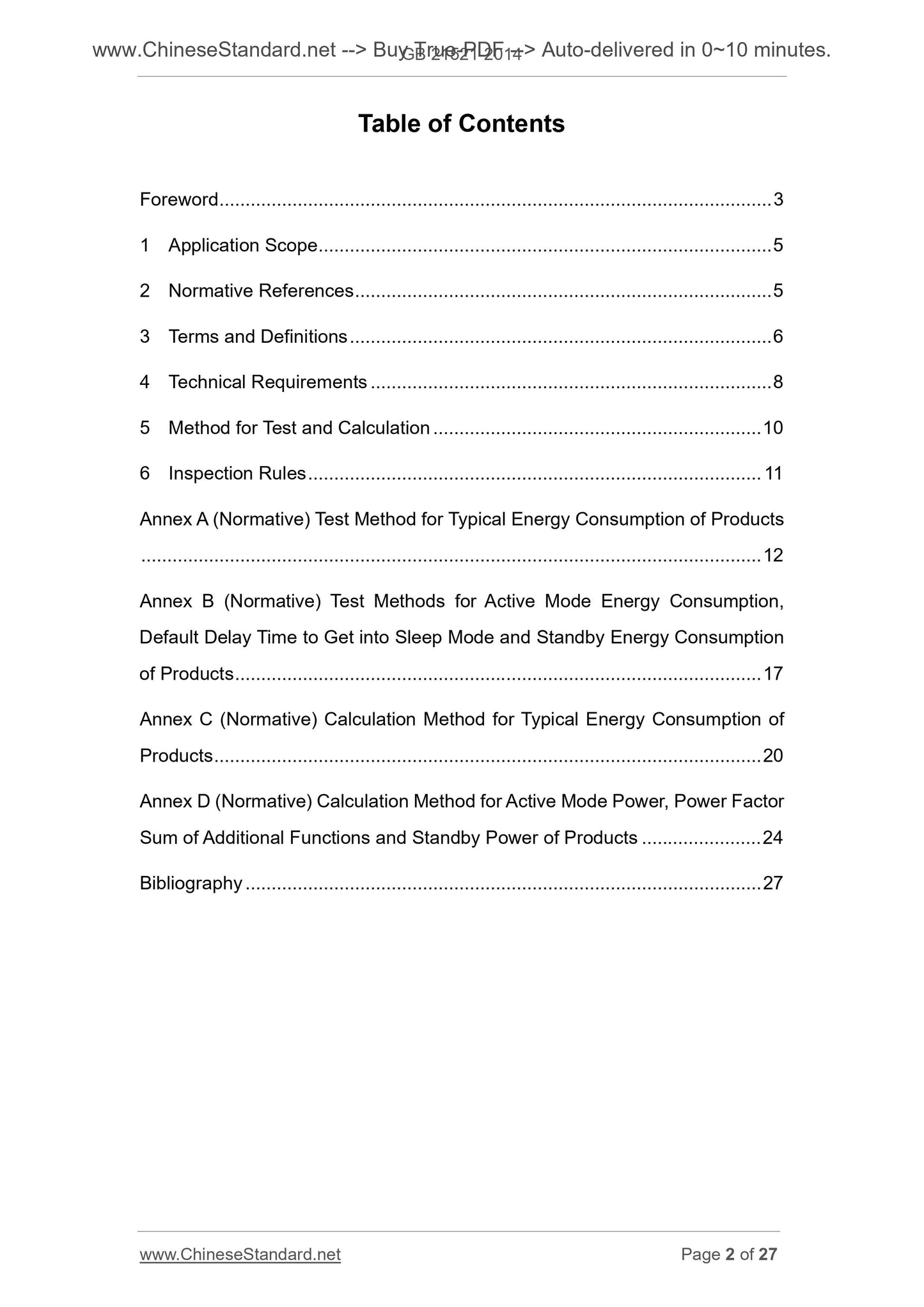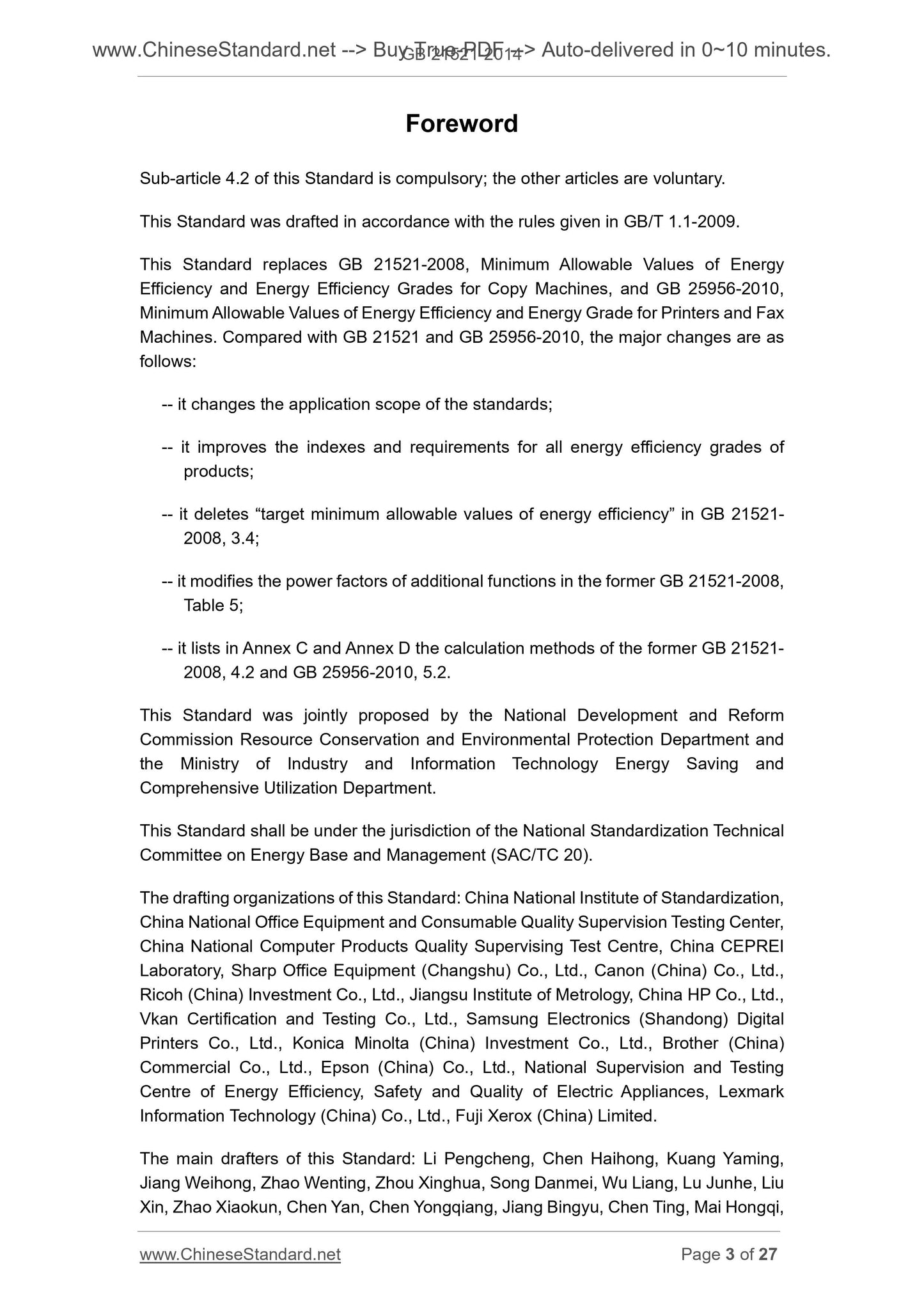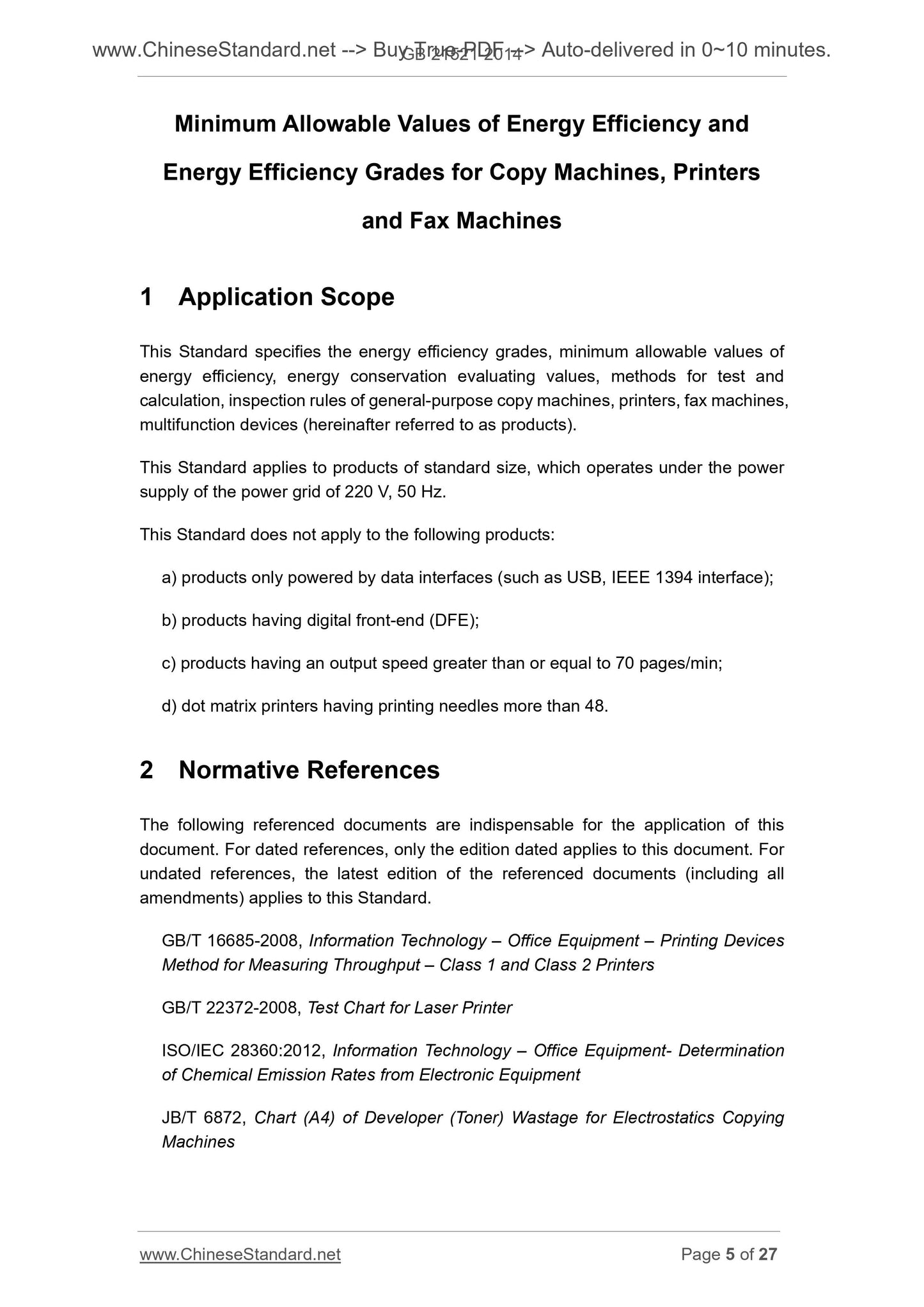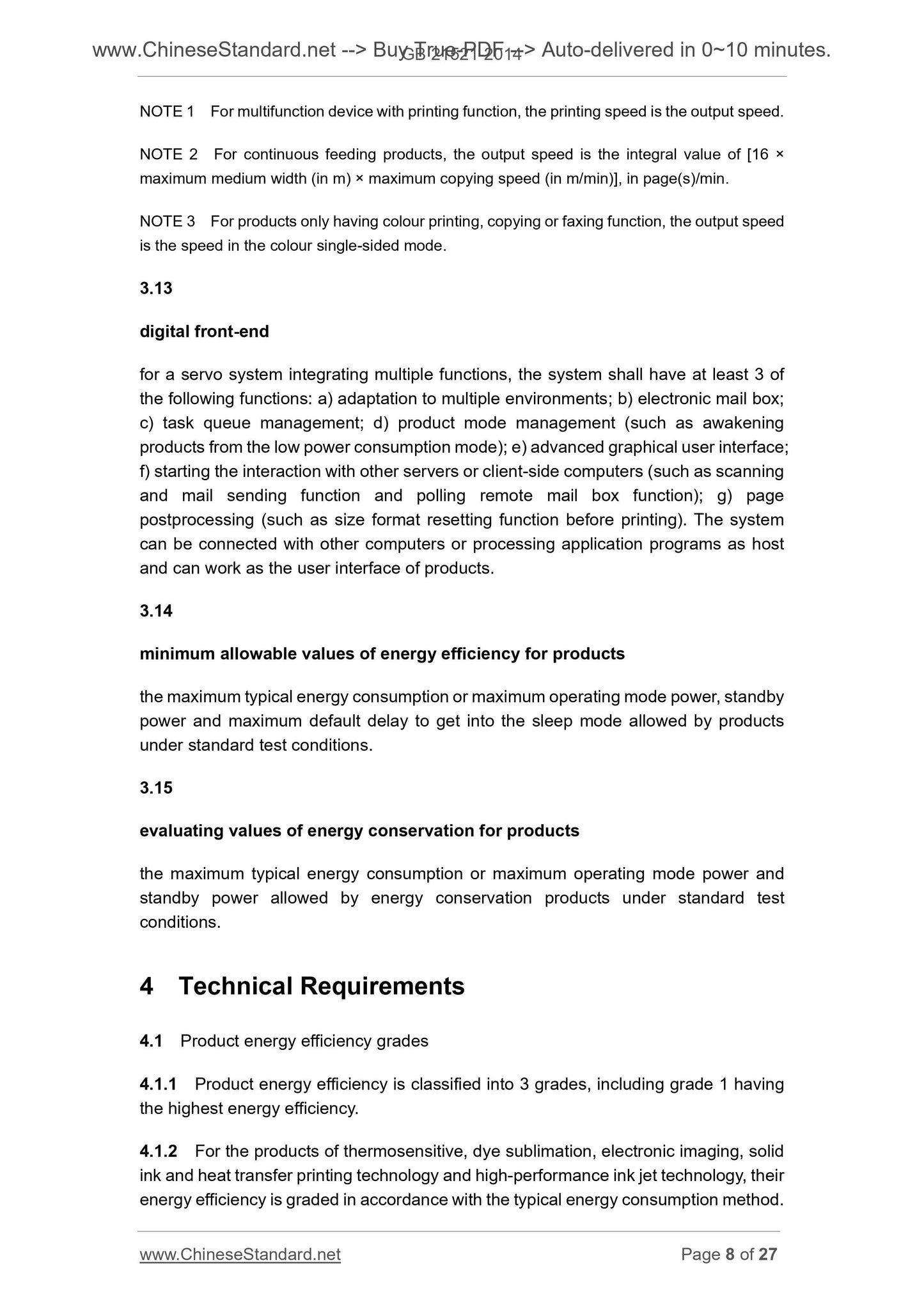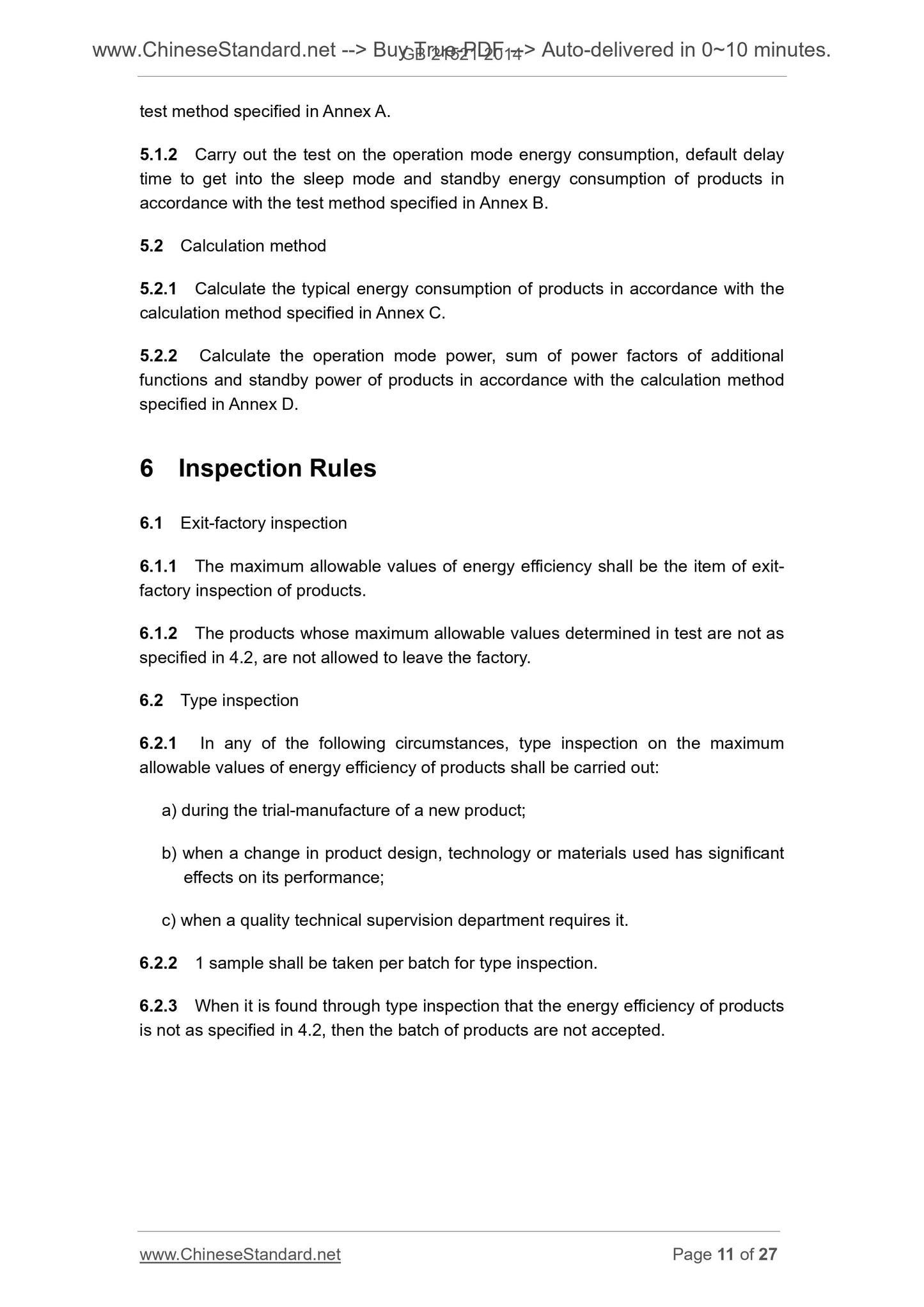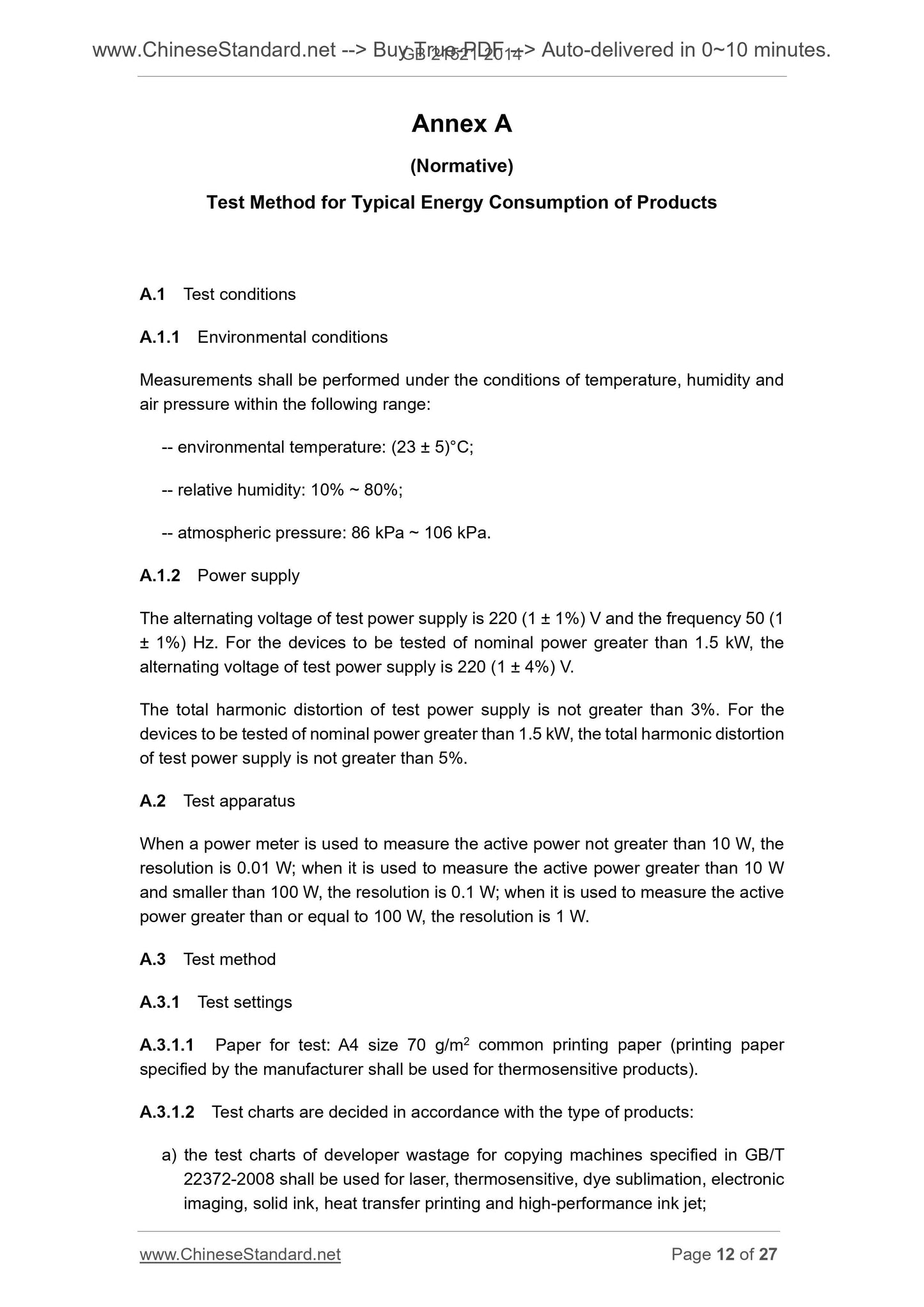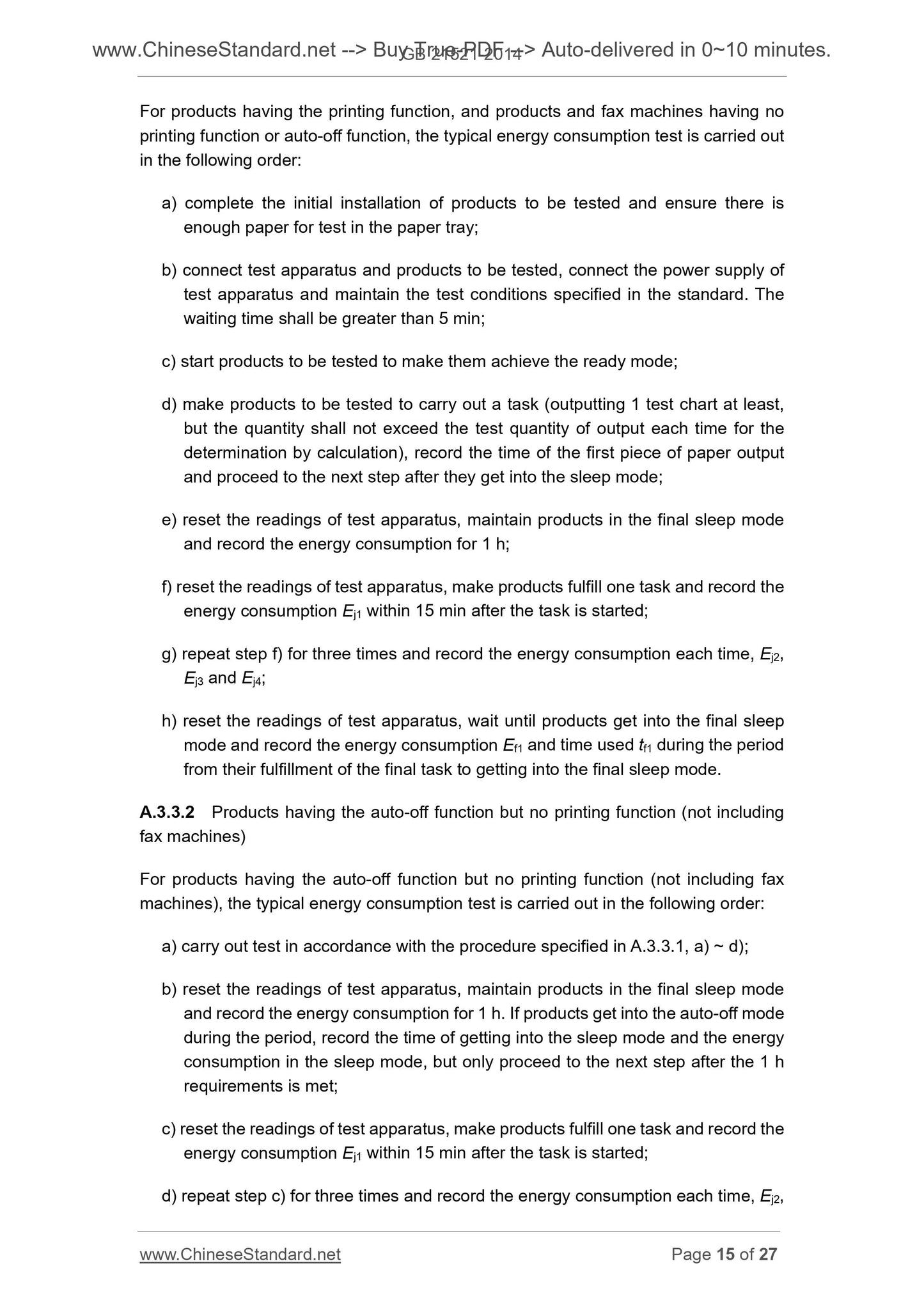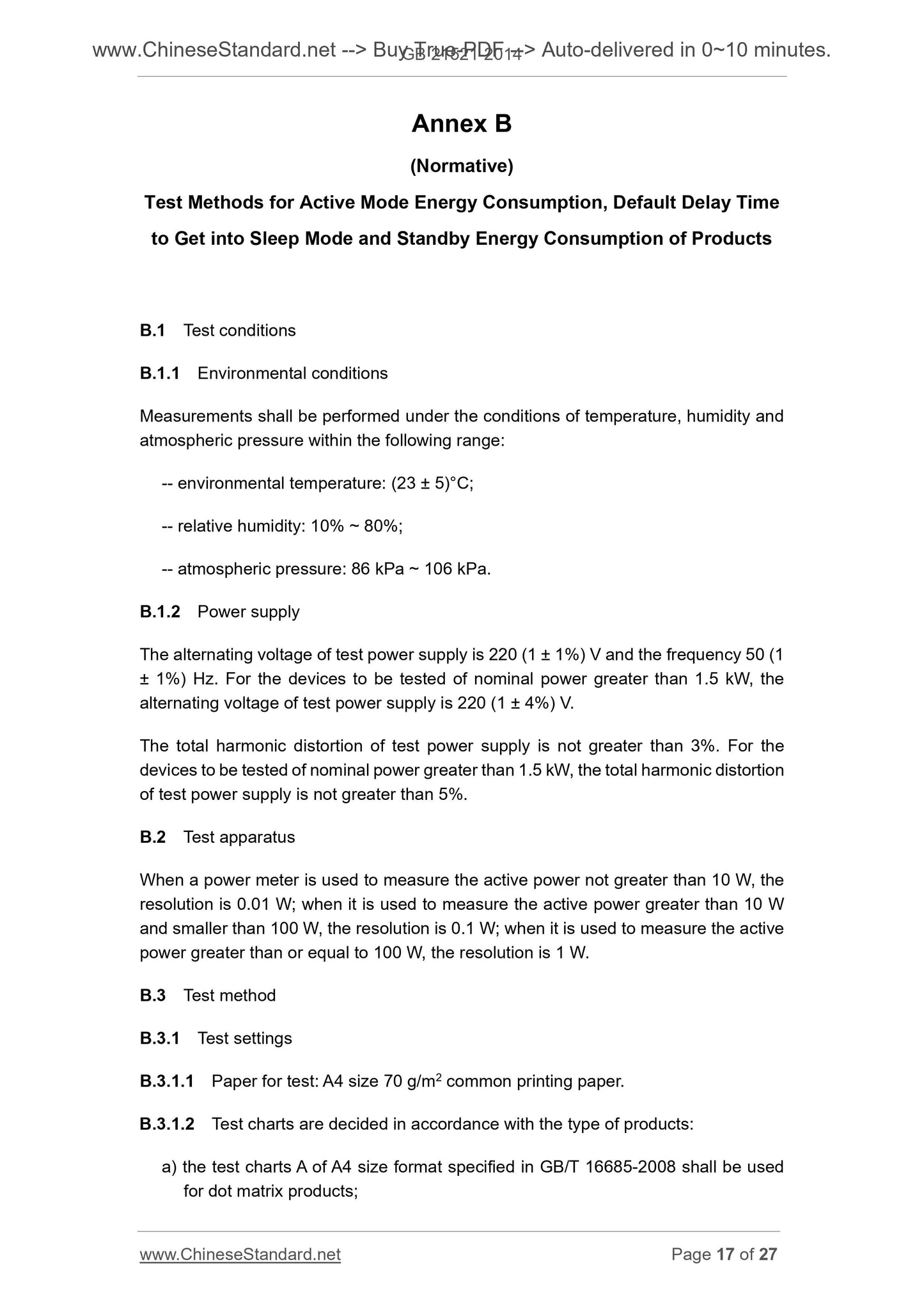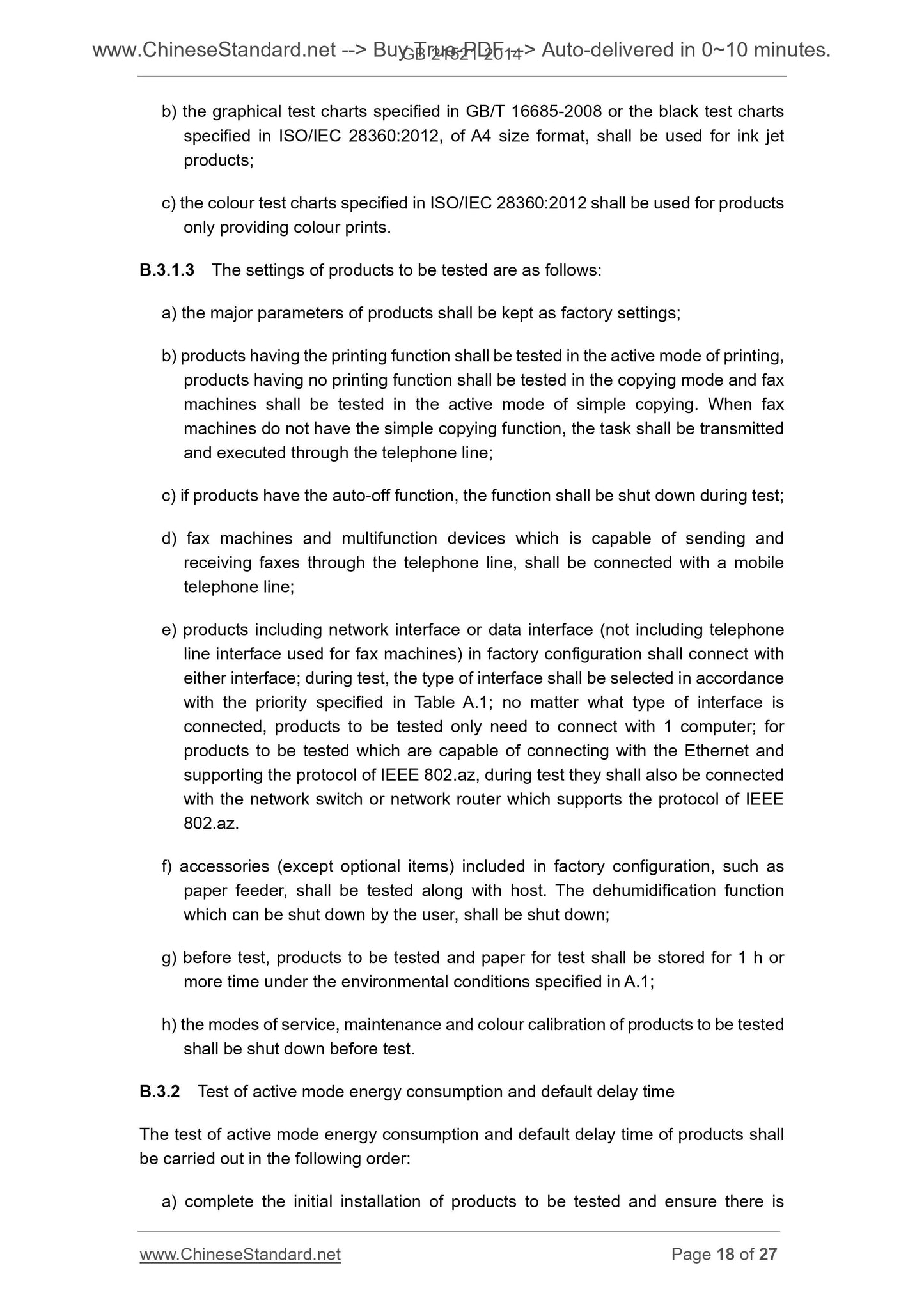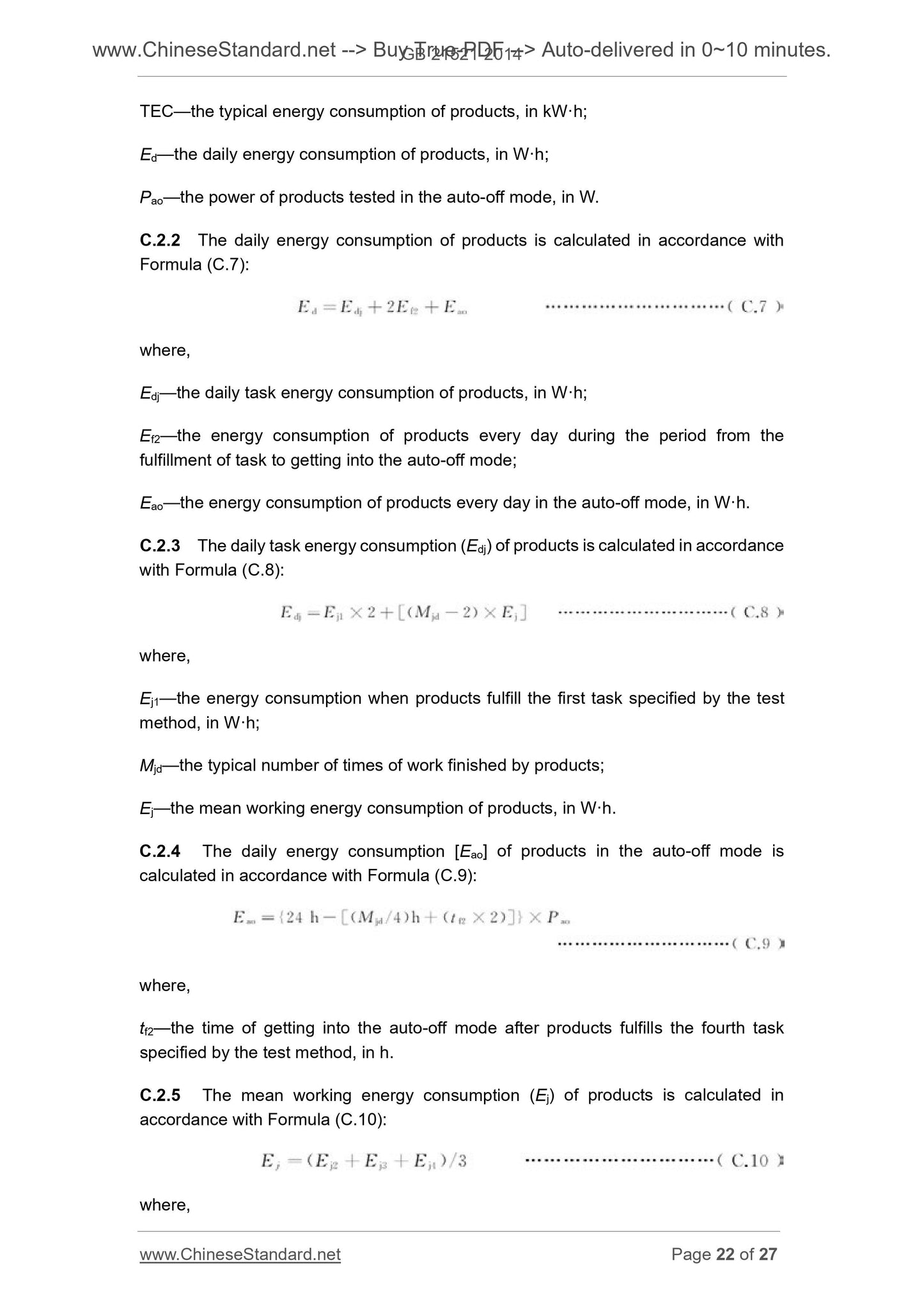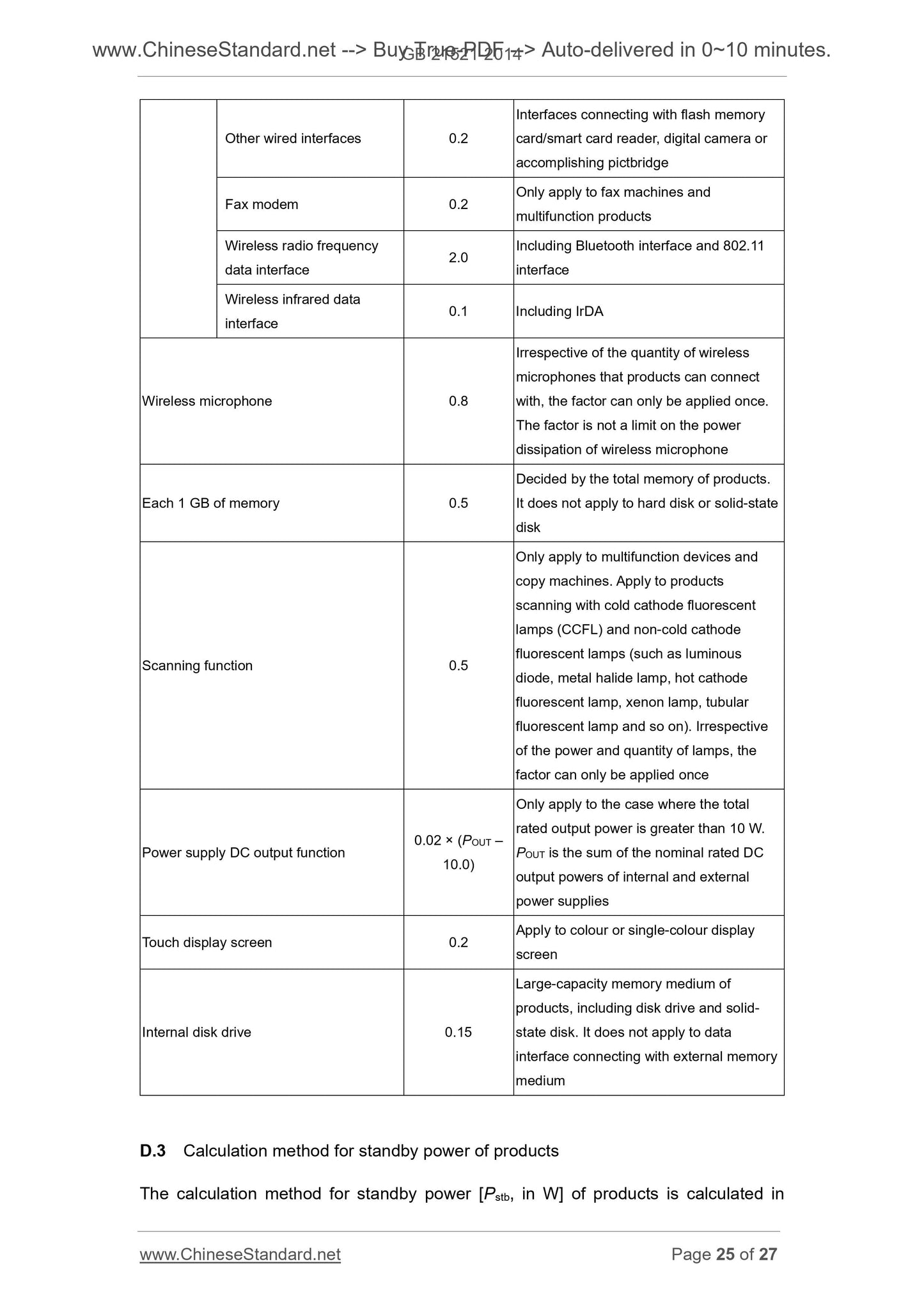1
/
of
12
PayPal, credit cards. Download editable-PDF & invoice in 1 second!
GB 21521-2014 English PDF
GB 21521-2014 English PDF
Regular price
$85.00 USD
Regular price
Sale price
$85.00 USD
Unit price
/
per
Shipping calculated at checkout.
Couldn't load pickup availability
Delivery: 3 seconds. Download true-PDF + Invoice.
Get QUOTATION in 1-minute: Click GB 21521-2014
Historical versions: GB 21521-2014
Preview True-PDF (Reload/Scroll if blank)
GB 21521-2014: Minimum allowable values of energy efficiency and energy efficiency grades for copy machines, printers and fax machines
GB 21521-2014
GB
NATIONAL STANDARD OF THE
PEOPLE’S REPUBLIC OF CHINA
ICS 27.010
F 01
Replacing GB 21521-2008, GB 25956-2010
Minimum Allowable Values of Energy Efficiency
and Energy Efficiency Grades for Copy Machines,
Printers and Fax Machines
ISSUED ON. APRIL 28, 2014
IMPLEMENTED ON. JANUARY 1, 2015
Issued by. General Administration of Quality Supervision, Inspection and
Quarantine of the People's Republic of China;
Standardization Administration of the People's Republic of
China.
3. No action is required - Full-copy of this standard will be automatically and
immediately delivered to your EMAIL address in 0~60 minutes.
Table of Contents
Foreword ... 3
1 Application Scope ... 5
2 Normative References ... 5
3 Terms and Definitions ... 6
4 Technical Requirements ... 8
5 Method for Test and Calculation ... 10
6 Inspection Rules ... 11
Annex A (Normative) Test Method for Typical Energy Consumption of Products
... 12
Annex B (Normative) Test Methods for Active Mode Energy Consumption,
Default Delay Time to Get into Sleep Mode and Standby Energy Consumption
of Products ... 17
Annex C (Normative) Calculation Method for Typical Energy Consumption of
Products ... 20
Annex D (Normative) Calculation Method for Active Mode Power, Power Factor
Sum of Additional Functions and Standby Power of Products ... 24
Bibliography ... 27
Foreword
Sub-article 4.2 of this Standard is compulsory; the other articles are voluntary.
This Standard was drafted in accordance with the rules given in GB/T 1.1-2009.
This Standard replaces GB 21521-2008, Minimum Allowable Values of Energy
Efficiency and Energy Efficiency Grades for Copy Machines, and GB 25956-2010,
Minimum Allowable Values of Energy Efficiency and Energy Grade for Printers and Fax
Machines. Compared with GB 21521 and GB 25956-2010, the major changes are as
follows.
-- it changes the application scope of the standards;
-- it improves the indexes and requirements for all energy efficiency grades of
products;
-- it deletes “target minimum allowable values of energy efficiency” in GB 21521-
2008, 3.4;
-- it modifies the power factors of additional functions in the former GB 21521-2008,
Table 5;
-- it lists in Annex C and Annex D the calculation methods of the former GB 21521-
2008, 4.2 and GB 25956-2010, 5.2.
This Standard was jointly proposed by the National Development and Reform
Commission Resource Conservation and Environmental Protection Department and
the Ministry of Industry and Information Technology Energy Saving and
Comprehensive Utilization Department.
This Standard shall be under the jurisdiction of the National Standardization Technical
Committee on Energy Base and Management (SAC/TC 20).
The drafting organizations of this Standard. China National Institute of Standardization,
China National Office Equipment and Consumable Quality Supervision Testing Center,
China National Computer Products Quality Supervising Test Centre, China CEPREI
Laboratory, Sharp Office Equipment (Changshu) Co., Ltd., Canon (China) Co., Ltd.,
Ricoh (China) Investment Co., Ltd., Jiangsu Institute of Metrology, China HP Co., Ltd.,
Vkan Certification and Testing Co., Ltd., Samsung Electronics (Shandong) Digital
Printers Co., Ltd., Konica Minolta (China) Investment Co., Ltd., Brother (China)
Commercial Co., Ltd., Epson (China) Co., Ltd., National Supervision and Testing
Centre of Energy Efficiency, Safety and Quality of Electric Appliances, Lexmark
Information Technology (China) Co., Ltd., Fuji Xerox (China) Limited.
The main drafters of this Standard. Li Pengcheng, Chen Haihong, Kuang Yaming,
Jiang Weihong, Zhao Wenting, Zhou Xinghua, Song Danmei, Wu Liang, Lu Junhe, Liu
Xin, Zhao Xiaokun, Chen Yan, Chen Yongqiang, Jiang Bingyu, Chen Ting, Mai Hongqi,
Minimum Allowable Values of Energy Efficiency and
Energy Efficiency Grades for Copy Machines, Printers
and Fax Machines
1 Application Scope
This Standard specifies the energy efficiency grades, minimum allowable values of
energy efficiency, energy conservation evaluating values, methods for test and
calculation, inspection rules of general-purpose copy machines, printers, fax machines,
multifunction devices (hereinafter referred to as products).
This Standard applies to products of standard size, which operates under the power
supply of the power grid of 220 V, 50 Hz.
This Standard does not apply to the following products.
a) products only powered by data interfaces (such as USB, IEEE 1394 interface);
b) products having digital front-end (DFE);
c) products having an output speed greater than or equal to 70 pages/min;
d) dot matrix printers having printing needles more than 48.
2 Normative References
The following referenced documents are indispensable for the application of this
document. For dated references, only the edition dated applies to this document. For
undated references, the latest edition of the referenced documents (including all
amendments) applies to this Standard.
GB/T 16685-2008, Information Technology – Office Equipment – Printing Devices
Method for Measuring Throughput – Class 1 and Class 2 Printers
GB/T 22372-2008, Test Chart for Laser Printer
ISO/IEC 28360.2012, Information Technology – Office Equipment- Determination
of Chemical Emission Rates from Electronic Equipment
JB/T 6872, Chart (A4) of Developer (Toner) Wastage for Electrostatics Copying
Machines
NOTE 1 For multifunction device with printing function, the printing speed is the output speed.
NOTE 2 For continuous feeding products, the output speed is the integral value of [16 ×
maximum medium width (in m) × maximum copying speed (in m/min)], in page(s)/min.
NOTE 3 For products only having colour printing, copying or faxing function, the output speed
is the speed in the colour single-sided mode.
3.13
digital front-end
for a servo system integrating multiple functions, the system shall have at least 3 of
the following functions. a) adaptation to multiple environments; b) electronic mail box;
c) task queue management; d) product mode management (such as awakening
products from the low power consumption mode); e) advanced graphical user interface;
f) starting the interaction with other servers or client-side computers (such as scanning
and mail sending function and polling remote mail box function); g) page
postprocessing (such as size format resetting function before printing). The system
can be connected with other computers or processing application programs as host
and can work as the user interface of products.
3.14
minimum allowable values of energy efficiency for products
the maximum typical energy consumption or maximum operating mode power, standby
power and maximum default delay to get into the sleep mode allowed by products
under standard test conditions.
3.15
evaluating values of energy conservation for products
the maximum typical energy consumption or maximum operating mode power and
standby power allowed by energy conservation products under standard test
conditions.
4 Technical Requirements
4.1 Product energy efficiency grades
4.1.1 Product energy efficiency is classified into 3 grades, including grade 1 having
the highest energy efficiency.
4.1.2 For the products of thermosensitive, dye sublimation, electronic imaging, solid
ink and heat transfer printing technology and high-performance ink jet technology, their
energy efficiency is graded in accor...
Get QUOTATION in 1-minute: Click GB 21521-2014
Historical versions: GB 21521-2014
Preview True-PDF (Reload/Scroll if blank)
GB 21521-2014: Minimum allowable values of energy efficiency and energy efficiency grades for copy machines, printers and fax machines
GB 21521-2014
GB
NATIONAL STANDARD OF THE
PEOPLE’S REPUBLIC OF CHINA
ICS 27.010
F 01
Replacing GB 21521-2008, GB 25956-2010
Minimum Allowable Values of Energy Efficiency
and Energy Efficiency Grades for Copy Machines,
Printers and Fax Machines
ISSUED ON. APRIL 28, 2014
IMPLEMENTED ON. JANUARY 1, 2015
Issued by. General Administration of Quality Supervision, Inspection and
Quarantine of the People's Republic of China;
Standardization Administration of the People's Republic of
China.
3. No action is required - Full-copy of this standard will be automatically and
immediately delivered to your EMAIL address in 0~60 minutes.
Table of Contents
Foreword ... 3
1 Application Scope ... 5
2 Normative References ... 5
3 Terms and Definitions ... 6
4 Technical Requirements ... 8
5 Method for Test and Calculation ... 10
6 Inspection Rules ... 11
Annex A (Normative) Test Method for Typical Energy Consumption of Products
... 12
Annex B (Normative) Test Methods for Active Mode Energy Consumption,
Default Delay Time to Get into Sleep Mode and Standby Energy Consumption
of Products ... 17
Annex C (Normative) Calculation Method for Typical Energy Consumption of
Products ... 20
Annex D (Normative) Calculation Method for Active Mode Power, Power Factor
Sum of Additional Functions and Standby Power of Products ... 24
Bibliography ... 27
Foreword
Sub-article 4.2 of this Standard is compulsory; the other articles are voluntary.
This Standard was drafted in accordance with the rules given in GB/T 1.1-2009.
This Standard replaces GB 21521-2008, Minimum Allowable Values of Energy
Efficiency and Energy Efficiency Grades for Copy Machines, and GB 25956-2010,
Minimum Allowable Values of Energy Efficiency and Energy Grade for Printers and Fax
Machines. Compared with GB 21521 and GB 25956-2010, the major changes are as
follows.
-- it changes the application scope of the standards;
-- it improves the indexes and requirements for all energy efficiency grades of
products;
-- it deletes “target minimum allowable values of energy efficiency” in GB 21521-
2008, 3.4;
-- it modifies the power factors of additional functions in the former GB 21521-2008,
Table 5;
-- it lists in Annex C and Annex D the calculation methods of the former GB 21521-
2008, 4.2 and GB 25956-2010, 5.2.
This Standard was jointly proposed by the National Development and Reform
Commission Resource Conservation and Environmental Protection Department and
the Ministry of Industry and Information Technology Energy Saving and
Comprehensive Utilization Department.
This Standard shall be under the jurisdiction of the National Standardization Technical
Committee on Energy Base and Management (SAC/TC 20).
The drafting organizations of this Standard. China National Institute of Standardization,
China National Office Equipment and Consumable Quality Supervision Testing Center,
China National Computer Products Quality Supervising Test Centre, China CEPREI
Laboratory, Sharp Office Equipment (Changshu) Co., Ltd., Canon (China) Co., Ltd.,
Ricoh (China) Investment Co., Ltd., Jiangsu Institute of Metrology, China HP Co., Ltd.,
Vkan Certification and Testing Co., Ltd., Samsung Electronics (Shandong) Digital
Printers Co., Ltd., Konica Minolta (China) Investment Co., Ltd., Brother (China)
Commercial Co., Ltd., Epson (China) Co., Ltd., National Supervision and Testing
Centre of Energy Efficiency, Safety and Quality of Electric Appliances, Lexmark
Information Technology (China) Co., Ltd., Fuji Xerox (China) Limited.
The main drafters of this Standard. Li Pengcheng, Chen Haihong, Kuang Yaming,
Jiang Weihong, Zhao Wenting, Zhou Xinghua, Song Danmei, Wu Liang, Lu Junhe, Liu
Xin, Zhao Xiaokun, Chen Yan, Chen Yongqiang, Jiang Bingyu, Chen Ting, Mai Hongqi,
Minimum Allowable Values of Energy Efficiency and
Energy Efficiency Grades for Copy Machines, Printers
and Fax Machines
1 Application Scope
This Standard specifies the energy efficiency grades, minimum allowable values of
energy efficiency, energy conservation evaluating values, methods for test and
calculation, inspection rules of general-purpose copy machines, printers, fax machines,
multifunction devices (hereinafter referred to as products).
This Standard applies to products of standard size, which operates under the power
supply of the power grid of 220 V, 50 Hz.
This Standard does not apply to the following products.
a) products only powered by data interfaces (such as USB, IEEE 1394 interface);
b) products having digital front-end (DFE);
c) products having an output speed greater than or equal to 70 pages/min;
d) dot matrix printers having printing needles more than 48.
2 Normative References
The following referenced documents are indispensable for the application of this
document. For dated references, only the edition dated applies to this document. For
undated references, the latest edition of the referenced documents (including all
amendments) applies to this Standard.
GB/T 16685-2008, Information Technology – Office Equipment – Printing Devices
Method for Measuring Throughput – Class 1 and Class 2 Printers
GB/T 22372-2008, Test Chart for Laser Printer
ISO/IEC 28360.2012, Information Technology – Office Equipment- Determination
of Chemical Emission Rates from Electronic Equipment
JB/T 6872, Chart (A4) of Developer (Toner) Wastage for Electrostatics Copying
Machines
NOTE 1 For multifunction device with printing function, the printing speed is the output speed.
NOTE 2 For continuous feeding products, the output speed is the integral value of [16 ×
maximum medium width (in m) × maximum copying speed (in m/min)], in page(s)/min.
NOTE 3 For products only having colour printing, copying or faxing function, the output speed
is the speed in the colour single-sided mode.
3.13
digital front-end
for a servo system integrating multiple functions, the system shall have at least 3 of
the following functions. a) adaptation to multiple environments; b) electronic mail box;
c) task queue management; d) product mode management (such as awakening
products from the low power consumption mode); e) advanced graphical user interface;
f) starting the interaction with other servers or client-side computers (such as scanning
and mail sending function and polling remote mail box function); g) page
postprocessing (such as size format resetting function before printing). The system
can be connected with other computers or processing application programs as host
and can work as the user interface of products.
3.14
minimum allowable values of energy efficiency for products
the maximum typical energy consumption or maximum operating mode power, standby
power and maximum default delay to get into the sleep mode allowed by products
under standard test conditions.
3.15
evaluating values of energy conservation for products
the maximum typical energy consumption or maximum operating mode power and
standby power allowed by energy conservation products under standard test
conditions.
4 Technical Requirements
4.1 Product energy efficiency grades
4.1.1 Product energy efficiency is classified into 3 grades, including grade 1 having
the highest energy efficiency.
4.1.2 For the products of thermosensitive, dye sublimation, electronic imaging, solid
ink and heat transfer printing technology and high-performance ink jet technology, their
energy efficiency is graded in accor...
Share
